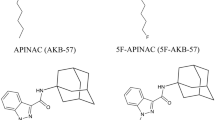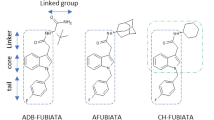Abstract
Although at a slower rate, new psychoactive substances continue to appear on the illicit drug market, challenging their detection in biological specimens by forensic and clinical toxicologists. Here, we report in vitro and in vivo metabolism of a new synthetic cannabinoid, methyl 3,3-dimethyl-2-[1-(pent-4-en-1-yl)-1H-indazole-3-carboxamido] butanoate (MDMB-4en-PINACA). This is the first report on metabolism of a synthetic cannabinoid with an alkene functional group at the alkyl side chain. MDMB-4en-PINACA was incubated with both human hepatocytes and human liver microsomes (HLM) for up to 5 h and 1 h, respectively. The samples were analyzed by liquid chromatography-quadrupole time-of-flight mass spectrometry. An authentic human urine and a corresponding blood sample were analyzed to confirm the in vitro metabolites. A total of 32 metabolites were detected, of which 11 metabolites were detected in hepatocyte samples, 31 in HLM, 2 in urine, and 1 in blood. Analysis of the metabolites revealed that the main metabolic pathway of the terminal alkene group of the pentenyl side chain is dihydrodiol formation, most likely via epoxidation. The majority of the metabolites were generated from ester hydrolysis and/or dihydrodiol formation with further hydroxylation and/or dehydrogenation. Two most abundant metabolites in hepatocyte incubation samples, M8 (ester hydrolysis and dihydrodiol) and M30 (ester hydrolysis), coincided the two detected urinary metabolites. Based on the results, M8 and M30 are proposed to be appropriate urinary markers for MDMB-4en-PINACA intake for screening, while the inclusion of the parent drug itself and M29 (hydroxylation) may be useful for confirmation purposes.




Similar content being viewed by others
References
European Monitoring Centre for Drugs and Drug Addiction. European drug report 2019: trends and developments. Luxembourg: Publications Office of the European Union; 2019.
Slovenian Police. Analytical report: MDMB-PINACA N1-pentyl-4-en isomer (MDMB-4en-PINACA) (C20H27N3O3). 2019. https://www.policija.si/apps/nfl_response_web/0_Analytical_Reports_final/MDMB-4en-PINACA%20(MDMB-PINACA%20N1-pentyl-4-en%20isomer)-ID-1951-18%20_report.pdf. Accessed 11 July 2019.
Banister SD, Longworth M, Kevin R, Sachdev S, Santiago M, Stuart J, et al. Pharmacology of Valinate and tert-Leucinate synthetic cannabinoids 5F-AMBICA, 5F-AMB, 5F-ADB, AMB-FUBINACA, MDMB-FUBINACA, MDMB-CHMICA, and their analogues. ACS Chem Neurosci. 2016;7(9):1241–54. https://doi.org/10.1021/acschemneuro.6b00137.
Banister SD, Moir M, Stuart J, Kevin RC, Wood KE, Longworth M, et al. Pharmacology of indole and indazole synthetic cannabinoid designer drugs AB-FUBINACA, ADB-FUBINACA, AB-PINACA, ADB-PINACA, 5F-AB-PINACA, 5F-ADB-PINACA, ADBICA, and 5F-ADBICA. ACS Chem Neurosci. 2015;6(9):1546–59. https://doi.org/10.1021/acschemneuro.5b00112.
Public Health Agency of Sweden. Fjorton nya ämnen klassas som narkotika eller hälsofarlig vara (in Swedish). https://www.folkhalsomyndigheten.se/nyheter-och-press/nyhetsarkiv/2018/november/fjorton-nya-amnen-klassas-som-narkotika-eller-halsofarlig-vara/ (2018). Accessed 11 July 2019.
Yeter O, Ozturk YE. Metabolic profiling of synthetic cannabinoid 5F-ADB by human liver microsome incubations and urine samples using high-resolution mass spectrometry. Drug Test Anal. 2019;11(6):847–58. https://doi.org/10.1002/dta.2566.
Truver MT, Watanabe S, Åstrand A, Vikingsson S, Green H, Swortwood MJ, et al. 5F-MDMB-PICA metabolite identification and cannabinoid receptor activity. Drug Test Anal. 2019. https://doi.org/10.1002/dta.2688.
Kusano M, Zaitsu K, Taki K, Hisatsune K, Ji N, Moriyasu T, et al. Fatal intoxication by 5F–ADB and diphenidine: detection, quantification, and investigation of their main metabolic pathways in humans by LC/MS/MS and LC/Q-TOFMS. Drug Test Anal. 2018;10(2):284–93. https://doi.org/10.1002/dta.2215.
Armenian P, Darracq M, Gevorkyan J, Clark S, Kaye B, Brandehoff NP. Intoxication from the novel synthetic cannabinoids AB-PINACA and ADB-PINACA: a case series and review of the literature. Neuropharmacology. 2018;134:82–91. https://doi.org/10.1016/j.neuropharm.2017.10.017.
Carlier J, Diao X, Scheidweiler KB, Huestis MA. Distinguishing intake of new synthetic cannabinoids ADB-PINACA and 5F-ADB-PINACA with human hepatocyte metabolites and high-resolution mass spectrometry. Clin Chem. 2017;63(5):1008–21. https://doi.org/10.1373/clinchem.2016.267575.
Watanabe S, Vikingsson S, Roman M, Green H, Kronstrand R, Wohlfarth A. In vitro and in vivo metabolite identification studies for the new synthetic opioids acetylfentanyl, acrylfentanyl, furanylfentanyl, and 4-fluoro-Isobutyrylfentanyl. AAPS J. 2017;19(4):1102–22. https://doi.org/10.1208/s12248-017-0070-z.
Minakata K, Yamagishi I, Nozawa H, Hasegawa K, Suzuki M, Gonmori K, et al. Sensitive identification and quantitation of parent forms of six synthetic cannabinoids in urine samples of human cadavers by liquid chromatography–tandem mass spectrometry. Forensic Toxicol. 2017;35(2):275–83. https://doi.org/10.1007/s11419-017-0354-0.
Åstrand A, Töreskog A, Watanabe S, Kronstrand R, Gréen H, Vikingsson S. Correlations between metabolism and structural elements of the alicyclic fentanyl analogs cyclopropyl fentanyl, cyclobutyl fentanyl, cyclopentyl fentanyl, cyclohexyl fentanyl and 2,2,3,3-tetramethylcyclopropyl fentanyl studied by human hepatocytes and LC-QTOF-MS. Arch Toxicol. 2019;93(1):95–106. https://doi.org/10.1007/s00204-018-2330-9.
Obach RS. Cytochrome P450-catalyzed metabolism of ezlopitant alkene (CJ-12,458), a pharmacologically active metabolite of ezlopitant: enzyme kinetics and mechanism of an alkene hydration reaction. Drug Metab Dispos. 2001;29(7):1057–67.
De Costa KS, Black SR, Thomas BF, Burgess JP, Mathews JM. Metabolism and disposition of α-methylstyrene in rats. Drug Metab Dispos. 2001;29(2):166–71.
Mang H, Gross J, Lara M, Goessler C, Schoemaker HE, Guebitz GM, et al. Biocatalytic single-step alkene cleavage from aryl alkenes: an enzymatic equivalent to reductive ozonization. Angew Chem Int Ed. 2006;45(31):5201–3. https://doi.org/10.1002/anie.200601574.
Wallgren J, Vikingsson S, Åstrand A, Josefsson M, Gréen H, Dahlén J, et al. Synthesis and identifications of potential metabolites as biomarkers of the synthetic cannabinoid AKB-48. Tetrahedron. 2018;74(24):2905–13. https://doi.org/10.1016/j.tet.2018.04.026.
Watanabe S, Kuzhiumparambil U, Fu S. Structural elucidation of metabolites of synthetic cannabinoid UR-144 by Cunninghamella elegans using nuclear magnetic resonance (NMR) spectroscopy. AAPS J. 2018;20(2):42. https://doi.org/10.1208/s12248-018-0209-6.
Watanabe S, Vikingsson S, Åstrand A, Auwärter V, Gréen H, Kronstrand R. Metabolism of the benzodiazepines norflurazepam, flurazepam, fludiazepam and cinolazepam by human hepatocytes using high-resolution mass spectrometry and distinguishing their intake in authentic urine samples. Forensic Toxicol. 2019. https://doi.org/10.1007/s11419-019-00488-9.
Brandon EFA, Raap CD, Meijerman I, Beijnen JH, Schellens JHM. An update on in vitro test methods in human hepatic drug biotransformation research: pros and cons. Toxicol Appl Pharmacol. 2003;189(3):233–46. https://doi.org/10.1016/S0041-008X(03)00128-5.
Diao X, Scheidweiler KB, Wohlfarth A, Pang S, Kronstrand R, Huestis MA. In vitro and in vivo human metabolism of synthetic cannabinoids FDU-PB-22 and FUB-PB-22. AAPS J. 2016;18(2):455–64. https://doi.org/10.1208/s12248-016-9867-4.
Minakata K, Hasegawa K, Nozawa H, Yamagishi I, Saitoh T, Yoshino A, et al. Sensitive quantification of BB-22 and its metabolite BB-22 3-carboxyindole, and characterization of new metabolites in authentic urine and/or serum specimens obtained from three individuals by LC–QTRAP-MS/MS and high-resolution LC–Orbitrap-MS/MS. Forensic Toxicol. 2019;37(1):164–73. https://doi.org/10.1007/s11419-018-0448-3.
Diao X, Huestis MA. New synthetic cannabinoids metabolism and strategies to best identify optimal marker metabolites. Front Chem. 2019;7:109. https://doi.org/10.3389/fchem.2019.00109.
Acknowledgments
This work was supported by the Vinnova (the EUROSTARS Psychomics project, grant number 10628) and the Strategic Research Area in Forensic Sciences (Strategiområdet forensiska vetenskaper, grant number 2016:7) at Linköping University.
Author information
Authors and Affiliations
Corresponding author
Additional information
Publisher’s Note
Springer Nature remains neutral with regard to jurisdictional claims in published maps and institutional affiliations.
Electronic Supplementary Material
ESM 1
(PDF 688 kb)
Rights and permissions
About this article
Cite this article
Watanabe, S., Vikingsson, S., Åstrand, A. et al. Biotransformation of the New Synthetic Cannabinoid with an Alkene, MDMB-4en-PINACA, by Human Hepatocytes, Human Liver Microsomes, and Human Urine and Blood. AAPS J 22, 13 (2020). https://doi.org/10.1208/s12248-019-0381-3
Received:
Accepted:
Published:
DOI: https://doi.org/10.1208/s12248-019-0381-3




